#acting studio lyon
Text
Opera on YouTube 3
Il Barbiere di Siviglia (The Barber of Seville)
Mario Lanfrachi studio film, 1965 (Sesto Bruscantini, Valeria Mariconda, Ugo Benelli; conducted by Alberto Zedda; no subtitles)
Jean-Pierre Ponnelle studio film, 1974 (Hermann Prey, Teresa Berganza, Luigi Alva; conducted by Claudio Abbado; English subtitles)
New York City Opera, 1976 (Alan Titus, Beverly Sills, Henry Price; conducted by Sarah Caldwell; English subtitles)
Arena Sferisterio, 1980 (Leo Nucci, Marilyn Horne, Ernesto Palacio; conducted by Nicola Rescingo; no subtitles)
Teatro Real de Madrid, 2005 (Pietro Spagnoli, Maria Bayo, Juan Diego Flórez; conducted by Gianluigi Gelmetti; Arabic subtitles)
Teatro la Fenice, 2008 (Roberto Frontali, Rinat Shaham, Francesco Meli; conducted by Antonino Fogliani; Italian subtitles)
Royal Opera House, Covent Garden, 2009 (Pietro Spagnoli, Joyce DiDonato, Juan Diego Flórez; conducted by Antonio Pappano; English subtitles)
Vienna State Opera, 2019 (Rafael Fingerlos, Margarita Gritskova, Juan Diego Flórez; conducted by Evelino Pidó; English subtitles)
Arena di Verona, 2022 (Leo Nucci, Nino Machaidze, Dmitry Korchak; conducted by Daniel Oren; English subtitles)
Garsington Opera, 2023 (Johannes Kamler, Katie Bray, Andrew Stenson; conducted by Douglas Boyd; English subtitles)
Rigoletto
Wolfgang Nagel studio film, 1977 (Rolando Panerai, Franco Bonisolli, Margherita Rinaldi; conducted by Francesco Molinari-Pradelli; Japanese subtitles)
Metropolitan Opera, 1977 (Cornell MacNeil, Plácido Domingo, Ileana Cotrubas; conducted by James Levine; no subtitles)
Metropolitan Opera, 1981 (Cornell MacNeil, Luciano Pavarotti, Christiane Eda-Pierre; conducted by James Levine; no subtitles)
Jean-Pierre Ponnelle film, 1982 (Ingvar Wixell, Luciano Pavarotti, Edita Gruberova; conducted by Riccardo Chailly, English subtitles)
English National Opera, 1982 (John Rawnsley, Arthur Davies, Marie McLaughlin; conducted by Mark Elder, sung in English)
La Monnaie, Brussels, 1999 (Anthony Michaels-Moore, Marcelo Álvarez, Elizabeth Futral; conducted by Vladimir Jurowski; no subtitles)
Arena di Verona, 2001 (Leo Nucci, Aquiles Machado, Inva Mula; conducted by Marcello Viotti; Italian subtitles)
Zürich Opera house, 2006 (Leo Nucci, Piotr Beczala, Elena Mosuc; conducted by Nello Santi; no subtitles)
Paris Opera, 2016 (Quinn Kelsey, Michael Fabiano, Olga Peretyatko; conducted by Nicola Luisotti; English subtitles)
Teatro Massimo, 2018 (George Petean, Ivan Ayon Rivas, Grazia Schiavo; conducted by Stefano Ranzani; English subtitles)
Così Fan Tutte
Vaclav Kaslik studio film, 1969 (Gundula Janowitz, Christa Ludwig, Luigi Alva, Hermann Prey; conducted by Karl Böhm; English subtitles)
Jean-Pierre Ponnelle studio film, 1988 (Edita Gruberova, Delores Ziegler, Luis Lima, Ferruccio Furlanetto; conducted by Nikolaus Harnoncourt; English subtitles) – Act I, Act II
Teatro alla Scala, 1989 (Daniela Dessì, Delores Ziegler, Josef Kundlak, Alessandro Corbelli; conducted by Riccardo Muti; Italian subtitles) – Act I, Act II
Théâtre du Châtelet, 1992 (Amanda Roocroft, Rosa Mannion, Rainer Trost, Rodney Gilfry; conducted by John Eliot Gardiner; English subtitles)
Vienna State Opera, 1996 (Barbara Frittoli, Angelika Kirschlager, Michael Schade, Bo Skovhus; conducted by Riccardo Muti; English and Italian subtitles)
Teatro Comunale di Ferrara, 2000 (Melanie Diener, Anna Caterina Antonacci, Charles Workman, Nicola Ulivieri; conducted by Claudio Abbado; no subtitles)
Zürich Opera House, 2000 (Cecilia Bartoli, Liliana Nikiteanu, Roberto Saccá, Oliver Widmer; conducted by Nikolaus Harnoncourt; no subtitles) – Act I, Act II
Opera Lyon, 2007 (Maria Bengtsson, Tove Dahlberg, Daniel Behle, Vito Priante; conducted by Stefano Montanari; French subtitles)
Salzburg Festival, 2009 (Miah Persson, Isabel Leonard, Topi Lehtipuu, Florian Boesch; conducted by Adam Fischer; English subtitles)
Zürich Opera House, 2009 (Malin Hartelius, Anna Bonitatibus, Javier Camarena, Ruben Drole; conducted by Frans Welser-Möst; English subtitles)
Aïda
San Francisco Opera, 1981 (Margaret Price, Luciano Pavarotti; conducted by Luis Garcia Navarro; no subtitles)
Metropolitan Opera, 1985 (Leontyne Price, James McCracken; conducted by James Levine; English subtitles) – Act I, Act II, Act III, Act IV
Teatro alla Scala, 1986 (Maria Chiara, Luciano Pavarotti; conducted by Lorin Maazel; English subtitles)
Metropolitan Opera, 1989 (Aprile Millo, Plácido Domingo; conducted by James Levine; English subtitles)
Teatro Comunale di Busseto, 2001 (Adina Aaron, Scott Piper; conducted by Massimiliano Stefaneli; Italian subtitles)
St. Margarethen Opera Festival, 2004 (Eszter Szümegi, Konstantin Andreev; conducted by Ernst Marzendorfer; English subtitles)
Metropolitan Opera, 2012 (Liudmyla Monastyrska, Roberto Alagna; conducted by Fabio Luisi; Russian subtitles)
Tbisili State Opera, 2017 (Maqvala Aspanidze, Franco Tenelli; conducted by Marco Boemi; Russian subtitles)
Teatro Colón, 2018 (Latonia Moore, Riccardo Massi; conducted by Carlos Vieu; Spanish subtitles)
Teatro la Fenice, 2019 (Roberta Mantegna, Francesco Meli; conducted by Riccardo Frizza; French subtitles)
#opera#youtube#complete performances#il barbiere di siviglia#rigoletto#così fan tutte#aida#gioachino rossini#giuseppe verdi#wolfgang amadeus mozart
16 notes
·
View notes
Text
Friendship Evolves: M3GAN Review

Pictured above is the “M3GAN” poster.
Image credit: Universal Pictures, BlumHouse Studios, Atomic Monster Productions
This review is going to be a little different because I usually review the theatrical version of the movies I cover, but for todays review I’m going to be reviewing the Unrated version of M3GAN as that was the version that was going to go to theaters before it got toned down to a PG-13 rating. I’m so excited that they released this version of M3GAN so soon after making $171.2 million in the global box office. So, lets get straight to the spoiler-free review.
M3GAN is a 2023 science fiction horror film directed by Gerard Johnstone, Written by Akela Cooper (Malignant (2021)), Produced by James Wan (who also directed Malignant (2021),and Jason Blum. The soundtrack is done by Anthony Willis. The cast involves Allison Williams as Gemma, Violet McGraw as Cady, Ronny Chieng as David, Amie Donald as M3GAN, Jenna Davis as the voice of M3GAN, Brian Jordan Alvarez as Cole, Jen Van Epps as Tess, Stephane Garneau-Monten as Kurt, Lori Dungey as Celia, Amy Usherwood as Lydia, Jack Cassidy as Brandon, Michael Saccente as Greg, Samson Chan-Boon as Officer Carter, Kira Josephson as Ava, Renee Lyons as Holly, and Arlo Green as Ryan.
The Plot:
M3GAN is a marvel of artificial intelligence, a lifelike doll that’s programmed to be a child’s greatest companion and a parent’s greatest ally. Designed by Gemma, a brilliant roboticist, M3GAN can listen, watch and learn as it plays the role of friend and teacher, playmate, and protector. When Gemma becomes the unexpected caretaker of her 8-year-old niece, she decides to give the girl an M3GAN prototype, a decision that leads to unimaginable consequences.
Positives:
One positive I have about the movie was the cast and the use of the character of M3GAN. An example of the use of M3GAN was the descent from a protective friend to an obsessive, psychotic, and cold-blooded killer…. who dances which had me laughing. I really liked the relationship of Cady and Gemma as they bond over time and how the bond they built pays off in the third act of the movie.
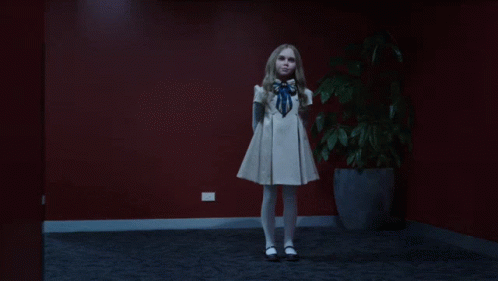
Pictured above is the M3GAN dance scene (which is already a meme)
Image Credit: Universal Pictures, BlumHouse Studios, and Atomic Monster Productions
The second positive I have about the movie is how they nailed the tone; it is campy but at the same time it is scary as hell considering the technology we have now. It also discusses the dangers of technology while not being too preachy.
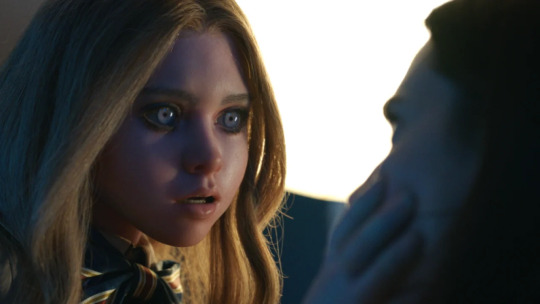
The third and final positive I have about the movie is the kills as it is bloody in the unrated version while kills in the PG-13 version happened offscreen and bloodless. The kills are pretty creative whether its with a power washer or a paper cutter, the movie (Unrated version) doesn’t hold back on the blood. While it’s not as bloody as “Terrifer 2” or the “Saw” franchise, some of the scenes are horrific.
Negatives:
The first negative I have about this movie is that I wish we spent a little bit more time with evil M3GAN. Evil M3GAN shows up at the halfway point of the movie, but that’s alright as it pays off. The second negative I have is some of the acting was questionable at some points, however it’s okay as it matches the campiness of the movie.
My overall thoughts:
After watching the unrated version of M3GAN, I believe releasing the unrated version a month after the PG-13 was released was a smart move considering the success of the PG-13 version. In saying that however, I believe this is the version that should have been released in theaters. If you are into killer doll movies or movies that deals with the dangers of artificial intelligence, then this is the movie for you. I found the movie to be really entertaining, darkly funny, and has rewatch value. I can’t wait until 2025 to see M3GAN 2.0
Where to watch M3GAN?
M3GAN can be watched on Peacock, Digital retailers, Blu-Ray, and DVD coming out March 21st, 2023.
What did you think about M3GAN?
Feel free to comment on this post and please keep the comments respectful.
Thank You
5 notes
·
View notes
Text
DESILU DOG POUND
Canine Companions on Lucycoms!

Woof! Open the kennels and take a look at all the dogs, pups, and canine pets in the Lucyverse!

In Annabel Takes a Tour (1938), Annabel (Lucille Ball) has a Terrier named Elmer.
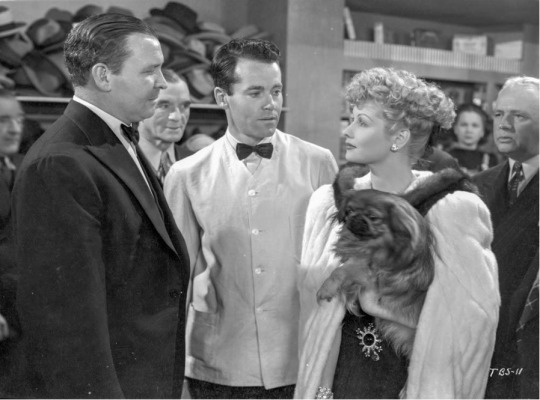
In The Big Street (1942), Gloria Lyons (Lucille Ball) has a lap dog she calls Baby. Pinks (Henry Fonda) rescues Baby from being run over by a car.

Probably one of the most famous dogs on television was Fred the dog. Little Ricky's friend Billy Palmer gave him a puppy to take home in January 1957 and he became part of the Ricardo family. Landlord Fred Mertz tells Lucy and Ricky their lease prohibits pets, but he bends the rules when Little Ricky names his puppy Fred.
LITTLE RICKY: “I always name my pets after people I like.”
Fred the dog was played by a Cairn Terrier named was Danny. He was trained by Bob Blair and was owned by Frank Inn. Danny also played Fremont, Mr. Wilson's dog on "Dennis the Menace" (1959-63). In films, he was Snuffy in Pal Joey (1957), Muffy in Anatomy of Murder (1959), and Pepe in the final Three Stooges short Sappy Bullfighters (1959). Fred the dog would make the move to Connecticut with the Ricardos, but is not seen or mentioned during “The Lucy-Desi Comedy Hour” episodes. While he was the most popular, Fred was not the only dog seen on “I Love Lucy”...
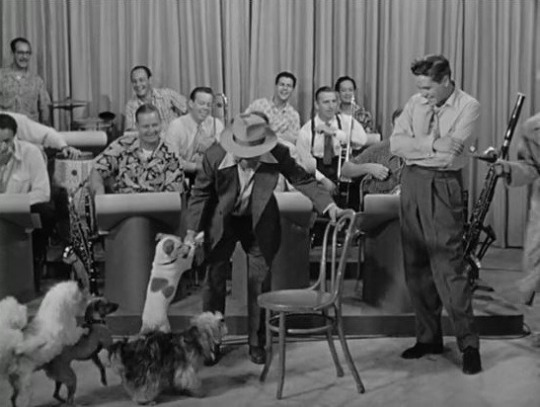
At the end of “Lucy Thinks Ricky is Trying to Murder Her” (1951), the very first episode of “I Love Lucy” filmed, a dog act makes an appearance. An established vaudeville act, Hector and His Pals was also seen in the film Easter Parade in 1948. The dog trainer Hector, calls one of the dogs by its real name ‘Yorkie’. In the episode, the dogs are named Ann, Mary, Helen, Cynthia, Alice, and Theodore. Lucy hears the dogs’ names and thinks they are women Ricky is having an affair with - until she hears Theodore!
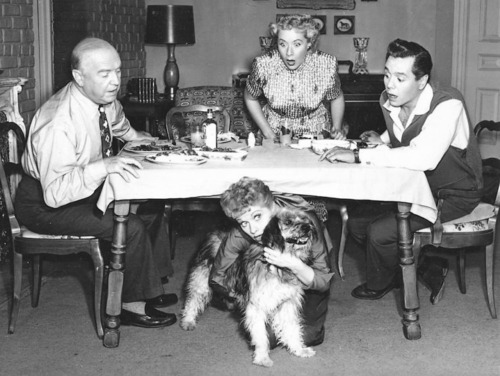
In the third episode aired, Butch, Fred’s mutt (as far as we can guess) stays under the table hoping for scraps in “The Diet” (1951) and then never heard of again. Unbeknownst to the others, a starving Lucy crawls under the table with Butch to intercept any tasty morsels meant for the dog.

Butch looks quite alarmed by the crazy lady under the table!

Sneaking into Richard Widmark’s mansion in “The Tour” (1955), Lucy hides under a bear rug - which just happens to be the favorite spot of Widmark’s St. Bernard Cap.
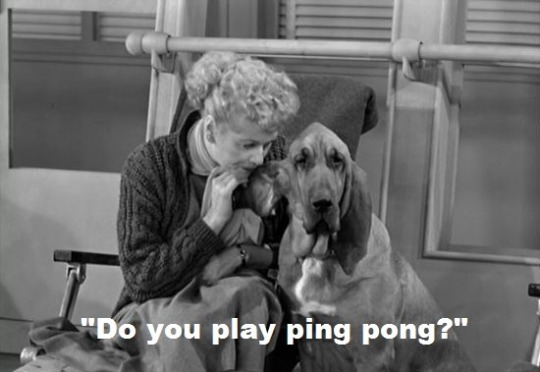
In “Second Honeymoon” (1956), a lonely Lucy asks Rocky the Bloodhound if he wants to play ping pong. Randy Rocky is tempted away by a French Poodle on a stroll.

Lassie, the most famous canine in Hollywood history, turned up on “The Desilu Revue” in 1959. The series was filmed at Desilu Studios. Lucy and Desi enlisted the participation of all the Desilu stars in their Christmas special. Lassie was first mentioned by Lucy Ricardo in “The Young Fans” (1952).

In the very first episode of “The Lucy Show” in 1962, Tiger the dog belongs to Lucy's neighbor and boyfriend Harry Connors (Dick Martin), who we will meet in episode two. A dog named Tiger was also featured on TV's “The Brady Bunch” (1969-1974). Here Tiger serves more as a plot device than pet. This is his one and only appeareance on the series.
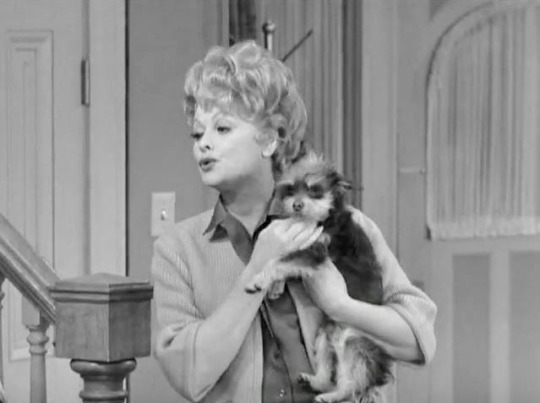
When “Lucy and Viv Learn Judo” (1963), the Carmichaels dogsit with Alvin, played by Hey! The dog belong’s to Jerry’s friend Amy Schaffer.

The final scene of the episode features a dozen dogs of various breeds, who come running at the silent sound of a dog whistle!
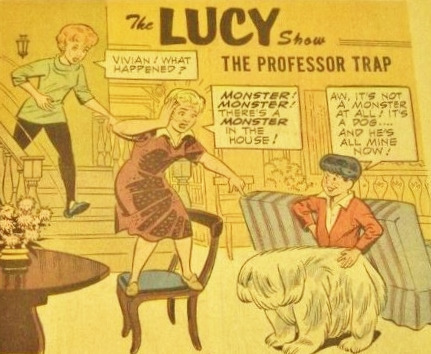
In the first frame of the June 1963 “The Lucy Show” Gold Key comic book, Jerry brings home a shaggy dog which Viv mistakes for a monster!

“Kiddie Parties Inc.” (1963) features Thunderbolt, a basset hound with more folds than an oragami swan.

In “Lucy is Her Own Lawyer” (1964) ~ Lucy complains when Mr. Mooney’s barking sheepdog Nelson (played by Lord Nelson) keeps her up all night. He tells her to sue him, and she does. After making a mockery of the court proceedings by acting as her own attorney, she finally wins her case by cross-examining Nelson. The neighborhood canines include:
Howard McAdams’ Pomeranian
Audrey Simmons’ Beagle
Grandma Sutton’s Airedale
The Hamilton’s Police Dog
Nelson is the only dog to appear on screen, with voice actor Pinto Colvig providing the off-screen barks for the other dogs.

Lord Nelson (Nelson) makes his first appearance as Mr. Mooney’s dog. He will also appear in “Lucy’s Contact Lenses” and would go on to appear on “Here’s Lucy” as Bogie in “Lucy and the Bogie Affair”. From 1965 to 1967, he played Ladadog (aka Lad) on “Please Don’t Eat the Daisies” and reprised the role of Nelson on “The Doris Day Show” from 1968 to 1971.

To keep Nelson in check, dog trainer Bob Blair plays the Bailiff.

In “Lucy and Clint Walker” (1965) Lightning, a lethargic Basset Hound, has a propensity to fall asleep, much like his master did Frank Winslow (Clint Walker) in “Lucy and the Sleeping Beauty”.
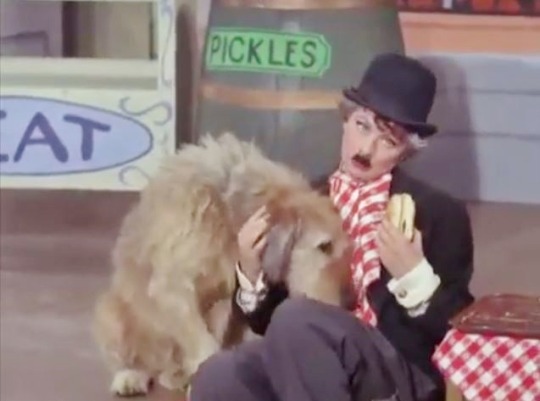
“Lucy Meets Mickey Rooney” (1966) has Lucy playing Charlie Chaplin in an acting school recital. The sketch features a mutt befriending the Tramp for his sandwich.
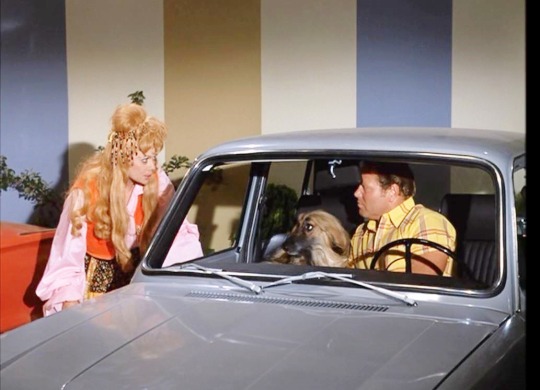
“Lucy at the Drive-In Movie” (1969) has Lucy searching through the passion pit cars for Kim and her new boyfriend. She mistakes an Afghan Hound for a long-haired woman.
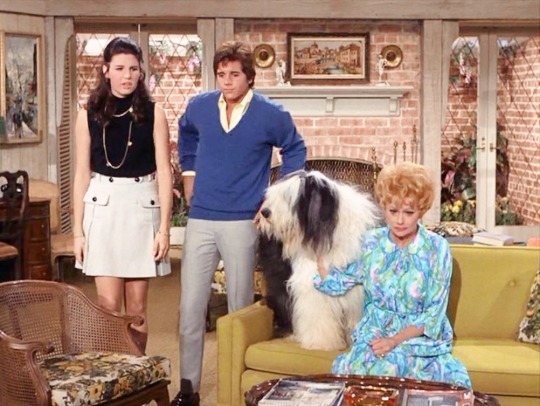
In “Lucy and the Bogie Affair” (1969) Kim and Craig bring home a stray sheepdog (played by Lord Nelson) which they call Bogie because it has the same sad look standing in the rain as Humphrey Bogart does at the end of 1942's Casablanca.

When Bogie turns out to be a she and gives birth to a litter of puppies, the Carters must find a home for the baby Bogies.
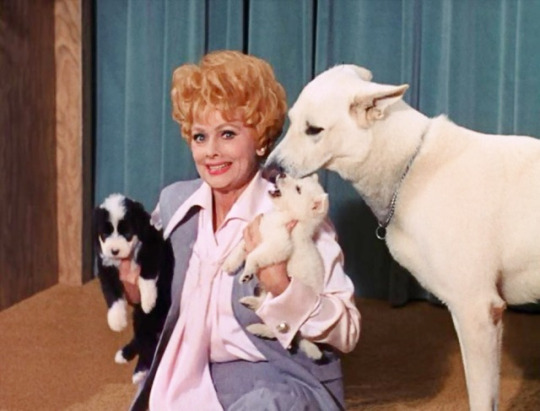
Lucy tries to give one of the pups to exercise guru Jack LaLanne, but only ends up taking one of Happy’s pups. Happy was LaLanne’s real-life dog appearing with him on many of his television shows.
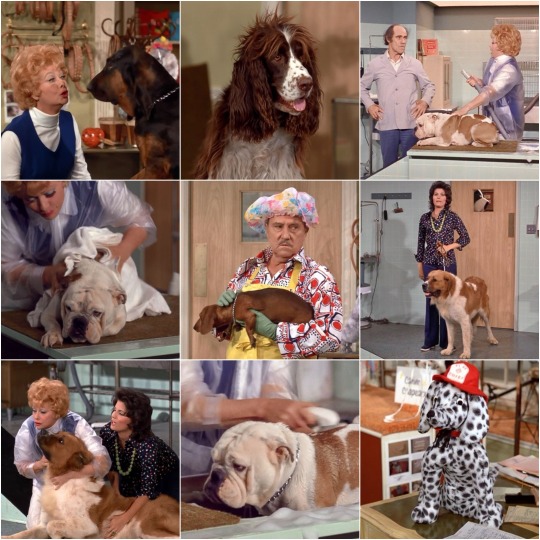
“The Bow-Wow Boutique” (1973) has Lucy, Kim and Harry opening a dog grooming business. Their clients include:
Louie, a French Spaniel
Winston, a Bloodhound
Teddy, an English Bulldog
Tiger, a Yorkshire Terrier
Tinkerbell, a St. Bernard
and an un-named Daschund
LUCY THE PUP






#Lucille Ball#Dogs#Pups#Puppies#Canine#I Love Lucy#The Lucy Show#Here's Lucy#Gale Gordon#Lucie Arnaz#Desi Arnaz#Vivian Vance#William Frawley#Lassie#Desi Arnaz Jr.#Jack LaLanne#Keith Thibodeaux
5 notes
·
View notes
Text
not to defend studio pav and 8d like I think there have been many points where they have been extremely disorganized in regards to this tour but lyons on twitter acting like they were held at gunpoint to make that video like um there’s no evidence or signs of mistreatment and they regularly do two show days when they’re in Japan I think it’s insulting to act like the guys don’t know what they can handle here like if I were them and I saw my fans working to get my show canceled instead of supporting it, I would be pissed
3 notes
·
View notes
Text
Davy Lyons presents: "One To One"
Davy Lyons' brand new single and video. It's the latest single taken from his highly acclaimed second album, 'The Human Factor'

Accompanying the release is a mesmerising videoclip directed by María Lorente Becerra, which promises to be a visual masterpiece in its own right. Set against the backdrop of Barcelona and the picturesque Delta del Ebro, the 'One to One' video features Lyons himself alongside actress Marta Rodrigo Díaz. Lyons previously showcased his acting talents in Adrià Pagès Molina's feature film "Solo Arrojaron,” released this year. 'One to One' is a soul-stirring ballad that explores the intricacies of various relationships - be it with a friend, a lover, a deity, or oneself. Its poignant lyrics and evocative melody create an emotional resonance that lingers long after the song ends.
youtube
In the video, viewers are introduced to two enigmatic characters, simply referred to as Him and Her. Despite being strangers, they share an inexplicable connection, as if tethered by invisible threads. Their parallel lives unfold simultaneously on screen, revealing shared desires and shared sorrows. As the narrative unfolds, it becomes evident that these two characters are intertwined in ways they cannot comprehend. There's a palpable sense of yearning and mutual dependence that transcends rationality. Ultimately, as the song reaches its crescendo, Him and Her fade into the ether, leaving behind a sense of wistful melancholy. Yet the vibrant landscapes of Barcelona and the bustling cityscape endure, unchanged by the ephemeral presence of these spectral figures.
DAVY LYONS BIO:
Davy Lyons is an Irish songwriter, musician, poet, and actor. Family gatherings in his childhood, where music was always vital, are the root of his creative endeavours. His first dream was to become a professional footballer. Having completed a First-Class Honours Masters degree in law at University College Dublin, Lyons abandoned the gavel for the guitar and began a spiritual journey across Europe that brought him to live and make wine in a Tuscan castle and stay for four months in the mythic Parisian bookshop, Shakespeare and Company, which has welcomed wandering writers such as Allen Ginsberg, James Baldwin, and Anaïs Nin.
Having lived in a camper van called Roger with three bearded artists for three sweaty months, he hitchhiked from Paris to Barcelona and settled finally in the Catalan city known as The Rose of Fire. There he played on the street, testing new songs and dodging the police. Busking brought him friends, money, and an understanding of how a good song is able to stand on its own, in its purest form, with guitar and voice, or no guitar at all. It was not all pleasant though, while busking he had eggs, water, and once a bag of shite thrown at him from balconies. You can’t please everybody.
In Barcelona, Lyons formed a band with some of the finest musicians in the city, and they began playing free folk, completely in the moment, with no song being the same from concert to concert. Their live shows developed a reputation as intense, binding, and unique experiences for the audience, an intimate journey where words and melodies come together, where silences are allowed to reverberate. Sound poems written with the fountain pen of Lyons’ soul with brushstrokes of folk, jazz, and gypsy added by the band.
In Angel Sound Studio, they recorded “Evidence”, Lyons’ debut album, produced by Arthur Jeffes, frontman of Penguin Cafe. The album was released in 2019 with Catalan label Delirics, and was launched with sold-out shows in Barcelona, and in his hometown, Wexford, the sunny south-east of Ireland. Catalan music magazine, Enderrock, said: Evidence is ten songs made for introspective people, those who wish to scratch inside without fear of finding deep sadness or divine beauty. The best of the album is how silence breathes.
The following year he began recording demos with Irish producer, David Duffy, in his home studio next to the Hare Krishna temple in Barcelona’s gothic quarter. Those demos form the basis of Lyons’ second record, “The Human Factor”, recorded in Vertigo Studios in Llinars del Vallès, and to be released in Feb 2022 with Dutch label, King Forward Records. Lyons bonded with label founder, Frank Bond, over an eel sandwich while on tour in the Netherlands. The album represents lyrical and musical growth for an artist who always submits himself to the hammer and anvil of metre and rhyme.
Following in his father’s footsteps, Lyons has just finished shooting for a feature-length Catalan-produced movie, where he plays the lead role in a story of friendship and grief. For the release of his first book, he is currently compiling a selection of poetry and prose sent over the last four years as part of the newsletters delivered every Sunday for his Patreon.
He is influenced by artists such as Jacques Brel, Francis Bacon, Nina Simone, John McGahern, Mick Mulcahy, Kae Tempest, and The Pecker Dunne.
Follow Davy Lyons on IG
0 notes
Text
DAY 05
Conduct in-depth research on 3 chosen Animators.
The Animators I chose were:
Felix Colgrave
Vincent Chansard
Shane Dering
FELIX COLGRAVE
youtube
Felix Colgrave is 31 years old at this time, he was born in Railton, Australia on 29th November 1992, where his nationality is also Australian. He is currently residing in Melbourne with his wife Zoë and his child. His wife Zoë is a costume and makeup-artist (Trugglet on Instagram). He is an independent animator as well as a director, cartoonist, filmmaker, artist, and musician.
Currently, his profession is being a YouTube content creator.
According to an interview on Felix Colgrave, he animated a lot as a kid, mostly on various flipbooks and assorts similar to that, it was not until he turned 16 when he started animating professionally. The first animation he produced was back in 2009, ‘Last Resort’. He created his YouTube channel in 2008 where his previous username was MasterAardvark.
YouTube acted as a reliable platform for Felix to display his work with a global audience. You could say his channel became a haven for those who appreciated unconventional and visually appealing content.
His animations always utilized a consistent style of a blend of absurdity, surrealism, and artistic brilliance.
The way he would produce his films is by preparing the opening shot and then proceeding to work on everything else in chronological order once the opening is built. He says it’s better that he doesn’t write anything, and he’d receive results that only his art form can do. He works in a studio in Melbourne with 7 other freelance animators where they look out for each other.
He likes to blend visual and auditory elements to create works of art that resonate with his style.
He won a lot of awards for his animated short films like ‘Double King’ and ‘The Elephant’s Garden’ which are featured in the book titled Australian Animation: An International History
VINCENT CHANSARD
There was not much information on Vincent Chansard, however I got some info from a transcript in an interview.
Chansard was brought up in Lyon, France, where he developed a fascination for art and animation from a young age. According to him, his childhood was embedded in a world of creativity. He spent hours drawing and sketching cartoon characters and comics. Through this emerged his interest in and subsequent formal training in animation.
He attended École Émile Cohl in Lyon, a renowned institution for art and animation. When he was there, Chansard refined his drawing and story-telling skills. He studied animation techniques that laid the foundation for his career in the industry.
Chansard’s creativity was influenced by masters of animation such as Hayao Miyazaki and Studio Ghibli and contemporary artists and filmmakers. They inspired him to redefine his talents and push his creative skills in animation beyond its perceived limits.
His work is characterized by attention to detail, emotional depth and visualization. He is passionate about telling stories through animation and connects emotionally with universal audiences. His art brings universal themes and messages to life.
Some of Chansards key projects and achievements include various animation projects such as short films, commercials and music videos. In all of these projects, he was able to bring unique creative expressions. The projects helped him to grow in his field.
He is excited to showcase new creative talent in his future projects and push his boundaries further. He is committed to continue to grow his artistic talents, explore new techniques and inspire fellow artists. He hopes to find new approaches to storytelling so that his audiences can be better captivated.
Vincent Chansard's artistic influences began in Lyon and continued to Lyon to École Émile Cohl and beyond. His journey through the world of art was dedicated to animation and storytelling. He is keen to continue to learn and explore better creative horizons. He wishes to continue to inspire generations of artists including his own and leave a lasting impact on his audiences.
SHANE DERING
There was not much information on Shane Dering, however I was able to claim some pieces of info from an interview on YouTube.
Shane Dering is 29 years old. He is an animator and illustrator at [adult swim]. He's always been drawing ever since he was a child, where his main inspiration for art originated from comic books, mostly Spiderman and Batman comics.
When he was around 13 (or 14) he claimed a copy of Adobe Flash CS3, which allowed him to produce ‘crappy’ internet animations/cartoons, moreover, creating a starting point for his interest in animation
He didn’t get any formal training, nor he didn’t attend any art schools, however he took a handful of classes in community college. Nonetheless he was mostly self-taught through watching YouTube videos, reading books, and watching cartoons.
The software he used was Adobe Flash, which he used for a very long time, and to him it was considered as a good starting program to sort of learn animation. Eventually he switched to Photoshop to produce 2D animations due to its variety of unique brush presets, however, he wasn’t a fan of the user interface. He commonly uses the creative studio provided by Adobe.
He does a bit of sound design, where he does almost all of the sound effects himself, and with the provision of music libraries from [adult swim] due to licensed contracts, he’s able to add music to his animations as well. He also does a tad bit of music here and there, but he prefers to leave it to the professionals.
He would display his animations up on his YouTube channel and on Newgrounds back in 2008 as a form of publicity along with building a portfolio because he was influenced by other expert animators on these platforms who put their work out there.
When he first got to [adult swim] as an intern and as a contractor, he wasn’t really an animator. He worked on [adult swim]'s creative team, who were responsible for the off air art like t shirt designs, cups etc.
He prepared a lot of digital illustrations and designs before that. But when he could try to do some animations, he would try to find people to show his work to at [adult swim] so he was able to get his animation portfolio to the right people.
His hobbies are music, he loves playing piano which is a particular reason as to why he loves to experiment with sound design and production, he loves going outside, snowboarding, and hiking with friends.
His art and animation style was mainly influenced by Japanese Animation, like Akira and Dragon Ball Z. He was also influenced by Studio Ghibli movies like Spirited Away.
0 notes
Text
Furies präsentieren weiteren neuen Song

Die FURIES präsentieren heute die brandneue Single 'Stars Of Burning Lands'. Der neue Track der französischen Heavy Metal Band wird geschmückt mit der kraftvollen Stimme von Cheyenne Janas, der neuen Frontfrau des Quintetts und Halbfinalistin bei "The Voice of France" 2020. Nach den beiden im vergangenen Jahr veröffentlichten Titeln mit den Sängerinnen Brittney Slayes (UNLEASH THE ARCHERS) und Alessia Scolletti (ERA) enthüllen die FURIES heute die außergewöhnliche stimmliche Handschrift von Cheyenne, die im vergangenen September zur Stammbesetzung stieß und verspricht, die zukünftigen Kompositionen der Gruppe zu neuen künstlerischen Höhen zu führen.
Hier geht es zum Video 'Stars Of Burning Lands'
Das von Antoine Doyen inszenierte Video wurde während eines Aufenthalts im Dezember 2023 im Studio 104 des Maison de la Radio in Paris gedreht. Für FURIES war es eine außergewöhnliche Gelegenheit, auf der Bühne dieses legendären Studios zu arbeiten, das die renommiertesten Künstler willkommen heißt.
Diese Veröffentlichung markiert den Beginn eines spannenden Kapitels für FURIES, die ihr Line-up vor einigen Monaten gefestigt haben und eifrig am Nachfolger vom Debütalbum "Fortune's Gate" arbeiten, welches 2020 veröffentlicht wurde.
Auf diesem neuen Titel vertiefen die Gitarren die Stimmung Die Aggressivität war bereits in der vorherigen Single „Poisoned“ spürbar, während der epische und schwere Stil beibehalten wurde, der für die Kompositionen von Furies charakteristisch ist. Die Atmosphäre ist düster, betont durch die imposante Basis des Schlagzeugs, und der Titel entfaltet sich wie eine immersive Klangleinwand, auf der Cheyennes Stimme mit ihrer fabelhaften Interpretation hervorsticht. „Stars of Burning Lands“ wurde von Guillaume komponiert und verbirgt in seinem Universum bestimmte Black-Metal-Einflüsse, die das von Slo illustrierte Kunstwerk inspirierten.
'Stars Of Burning Lands' wurde teilweise in den Labomatic Studios von Igor Moreno und in den verschiedenen Heimstudios der Musiker aufgenommen und von Simone Mularoni in den Dominations Studios gemischt und gemastert.
Das erste Album „Fortune’s Gate“, das im Oktober 2020 veröffentlicht wurde, sorgte in französischen und internationalen Medien für Aufsehen. Seitdem hat die Band einige Besetzungswechsel erfahren und besteht derzeit aus dem dynamischen Duo aus Schlagzeugerin Zaza Bathory und Gitarrist Guillaume Jockey.
Die FURIES haben nun eine neue Besetzung angekündigt, bestehend aus der erstaunlichen Sängerin Cheyenne Janas, Lucie Sue am Bass und Fred Bend an der Gitarre. Dieses frische Team, bestehend aus dem Gitarristen und Komponisten Guillaume Jockey und der Gründungsschlagzeugerin der Band, Zaza Bathory, hat am 28. Oktober 2023 zusammen mit ANIMALIZE, den Samurai des Universums, ihr Bühnendebüt beim Rock & Eat in Lyon gegeben.
Die FURIES haben zudem kürzlich einen Pariser Termin im Les Étoiles als Vorgruppe für die AMERICAN WINGS OF STEEL am 16. Mai 2024 angekündigt. Die Gruppe ist auch beim Furios Fest 2024 in Saint-Flour im kommenden August dabei.
Furies 2024:
Vocals: Cheyenne Janas
Guitars: Guillaume Jockey
Guitars: Fred Bend
Bass: Lucie Sue
Drums: Zaza Bathory
Heavy Metal der ursprünglichen Art, wie wir ihn aus den 80ern kennen, genau das liefern FURIES auch Anno 2023 ab. Die französische Band konnte bereits mit der EP-Kassette „Unleash The Furies“ in ihrem Heimatland für Furore sorgen. Mit Acts wie zum Beispiel CAULDRON, DIAMOND HEAD oder RAVEN teilten sich FURIES die Bühne, ebenso ergatterten die Vier sowohl einen Gig beim HELLFEST 2018 als auch einen Fernsehauftritt bei einem renommierten TV Sender. 2019 spielten die Vier zudem ihren ersten Deutschlandgig beim Taunus Metal Festival. Im Oktober 2020 erschien das Debütalbum "Fortune's Gate".
Quelle: Nauntown Music
Lesen Sie den ganzen Artikel
0 notes
Text
Sustainable development: new models in the race for decarbonisation

For manufacturers, like Groupe Atlantic, decarbonisation involves energy efficiency, the circular economy or even the repairability of their products
Against a backdrop of geopolitical instability, and while the surge in natural disasters makes the climate crisis more tangible than ever, the creation of a carbon-free economy is accelerating. It is in this tense context that COP28 is being held in Dubai from November 30 to December 12.
Deadly floods, uncontrollable fires, unprecedented droughts... Alarmist records follow one after another, making 2023 the year of all climatic extremes. Added to these glaring proofs of the fragility of the worldis a geopolitical furnace, as if all the visionaries were in agreement, with a view to bringing the economy in tune with more tenable practices. “France has understood that two decades of deindustrialisation have made it dependent, and therefore vulnerable, by making it lose its sovereignty over strategic subjects, hence a reindustrialization movement[1] which constitutes an opportunity for decarbonisation,” observes Thierry Vincent, the director of the MBA in energy transition management at Vinci Executive Education.[2]
Thus, despite a context of budgetary tension, which requires both public and private actors to play balancing acts, a general dynamic illustrates the wish to produce and consume in a more responsible, more sustainable, more sober, more frugal, less energy-intensive way, etc. “For a manufacturer like Groupe Atlantic[3], leader in the HVAC[4] sector, which implies products consuming energy throughout their life cycle, the main levers of decarbonisation are the use of renewable energies in our product mix, and the encouragement of energy sobriety[5], by developing connected solutions which promote a rational use of our equipment by customers", explains Isabelle Savidan, the CSR director of this French group, that employs 13,000 employees and achieved 3.2 billion euros in turnover in 2022.
Recycling and compostability
And Isabelle Savidan added that the Atlantic group, that will invest 150 million in a heat pump factory in Saône-et-Loire[6], as well as an additional 120 million euros, over three years, in the research and development of solutions thermodynamics, is also accelerating on the fronts of recycled materials, the compostability of packaging and the reparability of its products. They are also forced, under the pressure of the legislator and of their stakeholders, to engage in the ecological transition, SMEs are not left behind.
“Even if they do not always have the means or the skills, they have the willingness and awareness that we must focus on sustainability,” notes Flore Vallet, teacher-researcher at ESILV. Its work focuses on “the creation of multidisciplinary design tools for sustainability”, intended to support organisations, including SMEs, on the path to change. Like the Anthropolis chair[7] on the mobility of the future, at Paris-Saclay[8], which puts collective intelligence at the service of creating territorial value with less environmental impact.
Systematic approach
“The reflection must be very multifaceted, because carbon neutrality requires a systemic approach and the activation of all levers: preservation of resources, energy efficiency, alternative raw materials, eco-design, circular economy, CO2 storage, etc. », Lists Hervé Kleczewski, the co-founder of Waoup[9], a start-up studio in Lyon at the origin of around ten young shoots, that advocates the aggregation of expertise. “Most of these building blocks exist, but they need to be put together, and one company can't do it all alone,” he says.
Although state impetus is significant, technological or structural innovation most often takes place at the territorial level, as the government program “Territories of Industry”[10] rightly illustrates. A national strategy in favour of reindustrialisation, which is in line with the green industry bill[11]. If communities represent essential links in the equation, it is in particular “because we need shorter processing times for applications and land ready to accommodate these projects,” summarizes Thierry Vincent. “This is the condition for low-carbon reindustrialsation to be not a wishful thinking, but a concrete reality enabling France to retake control to reshape its destiny,” he concludes.
Source
Julie Le Bolzer, Développement durable : les nouveaux modèles dans la course à la décarbonation ? Les Echos, 29-11-2023 ; https://www.lesechos.fr/thema/articles/developpement-durable-les-nouveaux-modeles-dans-la-course-a-la-decarbonation-2037856
[1] Read also: https://lodelcar.tumblr.com/post/614389955074097152/the-mouth-mask-as-a-canary-in-the-coal-mine
[2] "De Vinci Executive Education represents the Executive activity of the Pôle Léonard de Vinci and has the initial aim of developing specialized MBAs and executive training for executives undergoing retraining, professionals wishing to develop their careers, as well as students already holders of a higher education qualification, who wish to specialize. Located in Paris-La Défense, Devinci Executive Education offers training intended for working professionals or students looking for strong specialization in the sectors of Management, Health, Transition and Digital." https://executive.devinci.fr/
[3] The Groupe Atlantic is a French HVAC company. It was founded in la Roche-sur-Yon (in Vendée region on the west coast of France) by Mr Radat and Mr Lamoure in 1968. Groupe Atlantic is based in 10 different countries with over 20 factories. The company has 20 factories, 10 of which are located outside France, and approximately 6,500 employees (as of March 2017), of which approximately 2,900 are outside France. Its mission is: "To transform prevailing energies into lasting well-being, by creating thermal comfort solutions that are ecologically efficient, accessible to all and suited to individual needs." Groupe Atlantic also own Ideal Boilers located in Hull, UK. https://www.groupe-atlantic.fr/
[4] heating, cooling and ventilation
[5] Read also: https://www.tumblr.com/earaercircular/697298111596527616/how-the-energy-hunger-of-digital-technologies-can?source=share
[6] Saône-et-Loire is a department in the Bourgogne-Franche-Comté region in France. It is named after the rivers Saône and Loire, between which it lies, in the country's central-eastern part. Saône-et-Loire is Bourgogne-Franche-Comté's most populous department with a population of 551,493 as of 2019.
[7] The « Anthropolis » chair is constructing a vision of future mobility integrating the major challenges of urban life such as reducing carbon emissions and improving quality of life in cities. Anthropolis develops fundamental methods to design mobility systems and services with a human-centred approach. We explore the following three complementary topics: future mobility and urban life, mobility as a service, and future infrastructures. https://www.chaire-anthropolis.fr/
[8] https://www.universite-paris-saclay.fr/en/about/universite-paris-saclay
[9] Waoup is a start-up studio with an impact on our health, our planet and our economy. https://www.waoup.com/
[10] The “Territories of Industry” initiative, launched at the end of 2018, is part of a State strategy for industrial reconquest and territorial development. A new phase of the program over 2023-2027 was announced by the President of the Republic in May 2023. https://www.entreprises.gouv.fr/fr/industrie/politique-industrielle/territoires-d-industrie
[11] Representatives and senators reached an agreement Monday evening 10-10-23 on the green industry bill. This aims to facilitate the establishment of factories, particularly in the sectors of batteries, heat pumps, wind power, solar panels and carbon-free hydrogen. To facilitate the establishment of new industries in five key sectors (heat pumps, wind power, solar panels, batteries and green hydrogen), the project provides for a simplification of administrative procedures. It should make it possible to halve the times for opening or expanding a factory, from 17 months on average to 9 actual months. https://www.lesechos.fr/politique-societe/societe/la-loi-sur-industrie-verte-franchit-une-etape-decisive-au-parlement-1986052
0 notes
Text
Les élèves de 2ème année de la formation Acting Studio Lyon : École d'Acteur sont fiers de vous présenter : “Tartuffe” de Molière mise en scène par Joëlle Sevilla et Alexis Henon au Théâtre Mascarille.
À partir du 27 Juin à 19h30.
🗺️ : 86 Quai Pierre Scize 69005 Lyon

1 note
·
View note
Text
Savage life download
DOWNLOAD NOW Savage life download


Savage and Tom Neal in a publicity still for DetourĪlthough Savage and Neal did not see eye-to-eye (she found him "childlike"), the duo would star together in Two Man Submarine and The Unwritten Code (both 1944) before their most famous film, the 1945 film noir Detour. She was a tireless seller of war bonds on two nationwide drives coordinated by Hollywood studios with the United States government. At this time, during World War II, Savage was also a popular pin-up model, including posing for a centerfold in Esquire shot by George Hurrell.

Īlthough Columbia typically groomed its girls in the mold of Rita Hayworth, Savage's look echoed Ann Sheridan, although her customary blonde locks were reddened for Footlight Glamour (1943) "so that the star, Penny Singleton, would be the only blonde on screen." She joined Joan Davis and Jinx Falkenburg in Two Senoritas from Chicago (1943) and starred (as a brunette) in the first of several outings with Tom Neal in Klondike Kate (1943). The two actresses featured together in What a Woman!, one of a dozen films with Savage released in 1943. Recalling Columbia mogul Harry Cohn as "a friendly Uncle type", Savage remembered Cohn being intimidated by acid-tongued Rosalind Russell. Savage instead made a screen test with Columbia Pictures-after playing Lorna in a Reinhardt acting showcase of Odet's Golden Boy" -and was offered a contract. Savage was offered a screen test by Fox, but she decided not to turn up, as she knew the studio already had a bevy of pretty blondes. The Reinhardt school's manager, Bert D'Armand, became Savage's agent, and the two later married. Reinhardt oversaw her name change, and Berniece became Ann Savage. Her MGM test did not work out, prompting her to get her teeth capped and acquire theatre training at the Max Reinhardt workshop on Sunset Boulevard. Ann spent time among the more famous Hollywood kids of the day, such as Lana Turner, Judy Garland, Freddie Bartholomew, and Deanna Durbin. She attended 64th Street Grammar School and Mount Vernon Junior High and first stepped on a sound stage at the age of 17 at MGM Studios and was screen tested by Edgar Selwyn. Growing up around the corner from the Jewelry District, the Broadway movie palaces of downtown Los Angeles served as her babysitter while her mother worked selling jewelry. After he died when Berniece was four years old, her mother moved the two of them to Los Angeles. During her early years, her family moved often as her father, an officer in the United States Army, relocated from base to base. Ann Savage was born Bernice Maxine Lyon in Columbia, South Carolina.
DOWNLOAD NOW Savage life download
1 note
·
View note
Photo
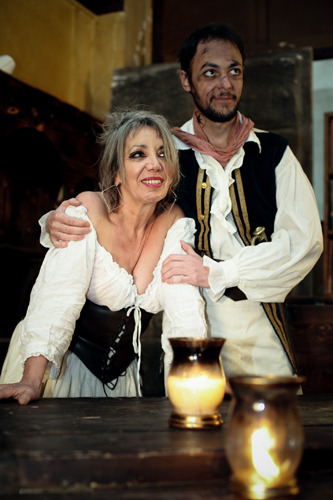
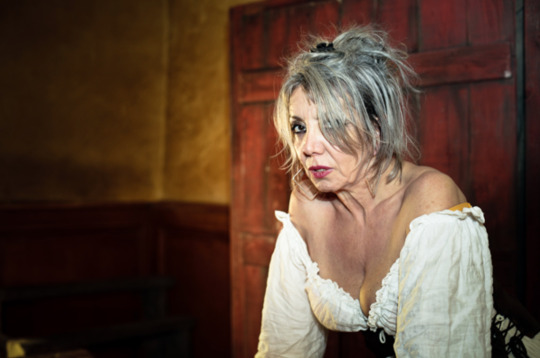
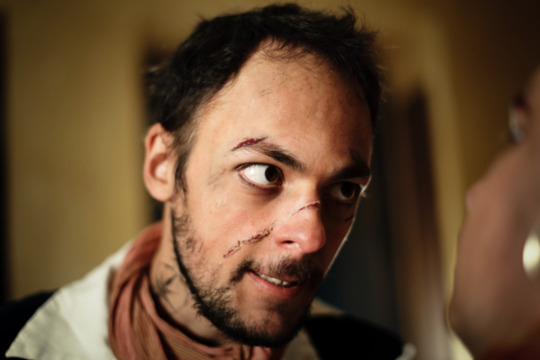



Photos du spectacle L’Étourdi ou les contre-temps de Molière, mis en scène par Joëlle Sevilla en 2011
Source des photos : le site du spectacle
Allez découvrir le spectacle en vidéos !
Avec
Joëlle Sevilla dans le rôle de Pandolfe et à la mise en scène
Aurélien Portehaut dans le rôle de Lélie
Yann Guillarme dans le rôle de Mascarille
Gabriel Da Costa dans le rôle de Léandre
Marie-Laure Rongier dans le rôle d’Hyppolite
Yohan Genin dans le rôle d’Andrès
Thierry Rousset dans le rôle d’Anselme
Alice Cancé dans le rôle de Nérine
Delphine Leputh dans le rôle de Célie
Jonathan Chiche dans le rôle d’Ergaste
Nicolas Musili dans le rôle de Trufaldin
@iloveallofyounerds - IL A UNE ÉPÉE, IT’S HOT !
#kaamelott#acting studio lyon#l'étourdi ou les contre-temps#molière#pirates#joelle sevilla#aurelien portehaut#it's for you Rizou ♥︎#swords + eye liner = peak sexiness#Aurélien Portehaut in the first pic = precious#Aurélien Portehaut in the last pic = gorgeous#Joëlle Sevilla = absolute queen looking cool as hell#séli#gauvain
19 notes
·
View notes
Note
Why do you think Danse hates the press so much, to the point of calling it a "necessary evil"?
Anon here is referencing Danse’s ambient comments if you take him to a “press room” (I’m guessing either the Boston Bugle building or the GNN HQ/Gunner’s Plaza.)
{Walking through the writer's room of a news facility. / Irritated} The Brotherhood finds the press to be... a necessary evil. In times of war, propaganda is just as important as bullets.
I wouldn’t describe this as *hate*, really... but I think the key is in another remark he makes about the press, but it’s actually from cut dialogue. Originally, it seems you were able to recruit Danse as a companion before your initial run-in with Piper outside Diamond City (this is not possible in the vanilla game anymore, as you cannot recruit Danse until after “Reunions,” which requires you to have already been to Diamond City at least once.)
Player Default: Always believed in freedom of the press.
Danse: I find that the press often manipulates the truth in order to deliver their agenda.
Danse is openly and outspokenly skeptical of pre-War institutions, in particular the government and corporations. As a member of the Brotherhood he has access to any archival news media that they may have rescued, and we know that he goes over archival records in his spare time. And given the state of the pre-War world, you can bet the news back then was absolutely loaded with propaganda and lies to suit the war effort and whatever the government wanted people to believe.
So really, he’s not... wrong, to believe this. (Take a look around our current real-world media landscape for dozens more examples of this.)
Post-War, there’s only a few media outlets he could even be referring to as the “press.” It’s possible he’s familiar with Piper’s newspaper Publick Occurrences, having been in the Commonwealth as long as he has, but he’s almost certainly more familiar with Galaxy News Radio back in the Capital Wasteland. Which was absolutely used by the Brotherhood to spread positive propaganda.
Back in Fallout 3, Lyons’ Brotherhood specifically protects the GNN studio and Three-Dog’s life, because Lyons believes the radio station is a worthy venture and a valuable commodity. Three-Dog is pleased to show his gratitude on-air, calling the Brotherhood “friends” and publicizing the various good acts they’re doing throughout the wasteland. It’s all true, and Three-Dog isn’t lying or exaggerating, but it’s also positive propaganda for the Brotherhood any way you slice it.
Danse is aware of the positive power of the press to spread the “good” news, but also skeptical of that power since he’s likely seen how it could be used to suit an agenda.
28 notes
·
View notes
Text
Meleko Mokgosi at Gagosian Britannia Street, London
September 2, 2020

MELEKO MOKGOSI
Democratic Intuition
September 29–December 12, 2020
6–24 Britannia Street, London
__________
Democracy is incompatible not only with the foundational elements of the human subject, but also with the various systems and institutions that support dominant forms of subjectivity or humanism in general. In other words, democracy is incompatible with structural racism and institutionalized or systemic violence; democracy is incompatible with neocolonialism and neo-imperialism; democracy is incompatible with the instruments that reproduce the conditions for and possibilities of capitalism; democracy is incompatible with race discourse, Eurocentrism, ethnocentrism, and humanism—all of which have become the dominant ways in which reality is conceptualized, interacted with, and historicized.
—Meleko Mokgosi
Gagosian is pleased to present Meleko Mokgosi’s first solo exhibition in the United Kingdom and Europe, drawn from his grand project Democratic Intuition (2014–19).
In works of sweeping scale and scope, Mokgosi combines history painting with cinematic montage, bringing together elements of religious iconography, advertising, and political propaganda from southern Africa and the United States to produce a layering of imagery both foreign and familiar. Reconceptualizing the intersection of art history, postcolonial nationhood, and democracy within an interdisciplinary critical framework, Mokgosi seeks to redress the many ways in which Black subjects have become unattributed objects of empire and institution.
Democratic Intuition is an eight-part epic that includes multi-panel depictions of southern African life and folklore; its title is a nod to Gayatri Spivak’s theory that the functioning of democracy is dependent upon accessible education. Mokgosi engages this concept and its internal contradictions through compelling genre scenes—often involving prominent public figures—that jump-cut between the confines of manual work, the freedoms of intellectual enterprise, and their ties to gender and race. A parade of finely drawn characters emerges out of raw canvas backgrounds, portraying the asymmetries of power that underscore traditional divisions of labor.
One chapter in the series, Bread, Butter, and Power (2018), is a twenty-one-panel panoramic painting that addresses the peripheral position of the Black female subject, constricted by the informal economic sectors of agricultural and domestic labor. In one panel, uniformed schoolgirls painted in meticulous detail till a field of soil rendered in broad abstract strokes; in another, two elderly women sit proudly in decorated state regalia; in a third, two women in period dress embrace in an imagined domestic tableau that contains, among other visual cues, a portrait of a defiant young Harriet Tubman, dressed in the black, green, and red of the Pan-African standard; a self-portrait by Cameroonian photographer Samuel Fosso in the guise of Black radical Angela Davis; and Mokgosi’s own protest poster in ANC colors, which refers to the people’s battle cry following the infamous Uitenhage massacre in 1985: THEY WILL NEVER KILL US ALL.
In another chapter titled Objects of Desire, individual small paintings of Afrocentric advertisements, Paleolithic cave paintings, and contemporary African objects are grouped together, dispensing with established representational hierarchies. Together with these images are text paintings in both English and Setswana, in which lines from museum wall labels, poems, and dinaane (oral histories) are accompanied by Mokgosi’s own critical marginalia. His annotations confront the erasure of African languages by racist policies under apartheid and reclaim these varied mother tongues. Key references for this chapter were the Museum of Modern Art’s controversial exhibitions “Primitivism” in Twentieth Century Art: Affinity of the Tribal and the Modern (1984–85) and Objects of Desire: The Modern Still Life (1997), both notorious for framing historical African artworks as anonymous sources for early European modernism.
Meleko Mokgosi was born in Francistown, Botswana, and lives and works between Wellesley, Massachusetts, and New York. He is codirector of graduate studies in painting and printmaking at the Yale School of Art, New Haven, CT, and cofounder of the Interdisciplinary Art and Theory Program, New York. Collections include the Studio Museum in Harlem, New York; Colby College Museum of Art, Waterville, ME; Baltimore Museum of Art; Williams College Museum of Art, Williamstown, MA; Pérez Art Museum Miami; and Hammer Museum, Los Angeles. Solo exhibitions include Democratic Intuition, Exordium, Institute of Contemporary Art, Boston (2015); Pax Kaffraria, Memorial Art Gallery of the University of Rochester and Rochester Contemporary Art Center, NY (2017); Lex and Love, Williams College Museum of Art, Williamstown, MA (2017); Acts of Resistance, Baltimore Museum of Art (2018); Bread, Butter, and Power, Fowler Museum at UCLA, Los Angeles (2018); Selections from the Hammer Contemporary Collection: Meleko Mokgosi, Hammer Museum, Los Angeles (2019); Bread, Butter, and Power, Smart Museum of Art, University of Chicago (2019); Pan-African Pulp, University of Michigan Museum of Art, Ann Arbor (2019–21); and Your Trip to Africa, Pérez Art Museum Miami (2020–21). Mokgosi participated in the 2013 Biennale de Lyon, Meanwhile... Suddenly, and Then.
Key chapters of Democratic Intuition were brought together in a major exhibition at The School in Kinderhook, New York, during 2019–20. A catalogue documenting the entire Democratic Intuition project will be copublished by Jack Shainman Gallery and Pacific Editions at the time of the London exhibition. During the exhibition, gagosian.com will host a curriculum and a series of online international seminars organized in collaboration with the artist.
_____
Meleko Mokgosi, Bread, Butter, and Power, 2018 (detail), oil, acrylic, bleach, graphite, photo and pigment transfer, and permanent marker on canvas, with plastic sleeve, in 21 parts; 1 part: 108 × 72 inches (274.3 × 182.9 cm), 18 parts, each: 96 × 96 inches (243.8 × 243.8 cm), 1 part: 96 × 132 inches (243.8 × 335.3 cm), 1 part: 84 × 12 × 12 inches (213.4 × 30.5 × 30.5 cm) © Meleko Mokgosi
15 notes
·
View notes
Text

Errol Leslie Thomson Flynn (20 June 1909 – 14 October 1959) was an Australian-born American actor during the Golden Age of Hollywood. Considered the natural successor to Douglas Fairbanks, he achieved worldwide fame for his romantic swashbuckler roles in Hollywood films, as well as frequent partnerships with Olivia de Havilland. He was best known for his role as Robin Hood in The Adventures of Robin Hood (1938); his portrayal of the character was named by the American Film Institute as the 18th-greatest hero in American film history. His other famous roles included the eponymous lead in Captain Blood (1935), Major Geoffrey Vickers in The Charge of the Light Brigade (1936), as well as the hero in a number of Westerns, such as Dodge City (1939), Santa Fe Trail (1940) and San Antonio (1945). Flynn also stirred controversy for his reputation as a womaniser and hedonistic personal life.
Errol Leslie Flynn was born on 20 June 1909 in Battery Point, a suburb of Hobart, Tasmania, Australia. His father, Theodore Thomson Flynn, was a lecturer (1909) and later professor (1911) of biology at the University of Tasmania. His mother was born Lily Mary Young, but shortly after marrying Theodore at St John's Church of England, Birchgrove, Sydney, on 23 January 1909, she changed her first name to Marelle. Flynn described his mother's family as "seafaring folk" and this appears to be where his lifelong interest in boats and the sea originated. Both of his parents were Australian-born of Irish, English and Scottish descent. Despite Flynn's claims, the evidence indicates that he was not descended from any of the Bounty mutineers.
Flynn received his early schooling in Hobart. He made one of his first appearances as a performer in 1918, aged nine, when he served as a page boy to Enid Lyons in a queen carnival. In her memoirs, Lyons recalled Flynn as "a dashing figure—a handsome boy of nine with a fearless, somewhat haughty expression, already showing that sang-froid for which he was later to become famous throughout the civilized world". She further noted: "Unfortunately Errol at the age of nine did not yet possess that magic for extracting money from the public which so distinguished his career as an actor. Our cause gained no apparent advantage from his presence in my entourage; we gained only third place in a field of seven."
From 1923 to 1925, Flynn attended the South West London College, a private boarding school in Barnes, London.
In 1926, he returned to Australia to attend Sydney Church of England Grammar School (known as "Shore"), where he was the classmate of a future Australian prime minister, John Gorton. His formal education ended with his expulsion from Shore for theft, although he later claimed it was for a sexual encounter with the school's laundress.
After being dismissed from a job as a junior clerk with a Sydney shipping company for pilfering petty cash, he went to Papua New Guinea at the age of eighteen, seeking his fortune in tobacco planting and metals mining. He spent the next five years oscillating between New Guinea and Sydney.
In January 1931, Flynn became engaged to Naomi Campbell-Dibbs, the youngest daughter of Robert and Emily Hamlyn (Brown) Campbell-Dibbs of Temora and Bowral, New South Wales. They did not marry.
Australian filmmaker Charles Chauvel was making a film about the mutiny on the Bounty, In the Wake of the Bounty (1933), a combination of dramatic re-enactments of the mutiny and a documentary on present-day Pitcairn Island. Chauvel was looking for someone to play the role of Fletcher Christian. There are different stories about the way Flynn was cast. According to one, Chauvel saw his picture in an article about a yacht wreck involving Flynn. The most popular account is that he was discovered by cast member John Warwick. The film was not a strong success at the box office, but Flynn’s was the lead role, and his fate was decided. In late 1933 he went to Britain to pursue a career in acting.
Flynn got work as an extra in a film, I Adore You (1933), produced by Irving Asher for Warner Bros. He soon secured a job with the Northampton Repertory Company at the town's Royal Theatre (now part of Royal & Derngate), where he worked and received his training as a professional actor for seven months. Northampton is home to an art-house cinema named after him, the Errol Flynn Filmhouse. He performed at the 1934 Malvern Festival and in Glasgow, and briefly in London's West End.
In 1934 Flynn was dismissed from Northampton Rep. after he threw a female stage manager down a stairwell. He returned to London. Asher cast him as the lead in Murder at Monte Carlo, a "quota quickie" made by Warner Brothers at their Teddington Studios in Middlesex. The movie was not widely seen (it is currently a lost film, but Asher was enthusiastic about Flynn's performance and cabled Warner Bros. in Hollywood, recommending him for a contract. Executives agreed, and Flynn was sent to Los Angeles.
On the ship from London, Flynn met (and eventually married) Lili Damita, an actress five years his senior whose contacts proved valuable when Flynn arrived in Los Angeles. Warner Bros. publicity described him as an "Irish leading man of the London stage."
His first appearance was a small role in The Case of the Curious Bride (1935). Flynn had two scenes, one as a corpse and one in flashback. His next part was slightly bigger, in Don't Bet on Blondes (1935), a B-picture screwball comedy.
Warner Bros. was preparing a big budget swashbuckler, Captain Blood (1935), based on the 1922 novel by Rafael Sabatini and directed by Michael Curtiz.
The studio originally intended to cast Robert Donat, but he turned down the part, afraid that his chronic asthma would make it impossible for him to perform the strenuous role.[19] Warners considered a number of other actors, including Leslie Howard and James Cagney, and also conducted screen tests of those they had under contract, like Flynn. The tests were impressive and Warners finally cast Flynn in the lead, opposite 19-year-old Olivia de Havilland. The resulting film was a magnificent success for the studio and gave birth to two new Hollywood stars and an on-screen partnership that would encompass eight films over six years. The budget for Captain Blood was $1.242 million, and it made $1.357 million in the U.S. and $1.733 million overseas, making a huge profit for Warner Bros.
Flynn had been selected to support Fredric March in Anthony Adverse (1936), but public response to Captain Blood was so enthusiastic that Warners instead reunited him with de Havilland and Curtiz in another adventure tale, this time set during the Crimean War, The Charge of the Light Brigade (1936). The film was given a slightly larger budget than Captain Blood, at $1.33 million, and it had a much higher box-office gross, earning $1.454 million in the US and $1.928 million overseas, making it Warner Bros.' No. 1 hit of 1936.
Flynn asked for a different kind of role and so when ill health made Leslie Howard drop out of the screen adaptation of Lloyd C. Douglas' inspirational novel, Flynn got the lead role in Green Light (1937), playing a doctor searching for a cure for Rocky Mountain Spotted Fever.[22] The studio then put him back into another swashbuckler, replacing Patric Knowles as Miles Hendon in The Prince and the Pauper (1937). He appeared opposite Kay Francis in Another Dawn (1937), a melodrama set in a mythical British desert colony. Warners then gave Flynn his first starring role in a modern comedy, The Perfect Specimen (1937), with Joan Blondell, under the direction of Curtiz. Meanwhile, Flynn published his first book, Beam Ends (1937), an autobiographical account of his experiences sailing around Australia as a youth. He also travelled to Spain, in 1937, as a war correspondent during the Spanish Civil War.
Flynn followed this with his most famous movie, The Adventures of Robin Hood (1938), playing the title role, opposite de Havilland's Marian. This movie was a global success. It was the 6th-top movie grosser of 1938.[25] It was also the studio's first large-budget color film utilizing the three-strip Technicolor process. The budget for Robin Hood was the highest ever for a Warner Bros. production up to that point—$2.47 million—but it more than made back its costs and turned a huge profit as it grossed $2.343 million in the U.S. and $2.495 million overseas.
It also received lavish praise from critics and became a worldwide favorite that has endured for generations. In 2019, Rotten Tomatoes summarizes the critical consensus: "Errol Flynn thrills as the legendary title character, and the film embodies the type of imaginative family adventure tailor-made for the silver screen." In 1995, the film was deemed "culturally, historically, or aesthetically significant" by the United States Library of Congress and selected for preservation by the National Film Registry.
The scene in which Robin climbs to Marian's window to steal a few words and a kiss has become as familiar to audiences as the balcony scene in Romeo and Juliet.[citation needed] Years later, in a 2005 interview, de Havilland described how, during the filming, she decided to tease Flynn, whose wife was on set and watching closely. De Havilland said, "And so we had one kissing scene, which I looked forward to with great delight. I remember I blew every take, at least six in a row, maybe seven, maybe eight, and we had to kiss all over again. And Errol Flynn got really rather uncomfortable, and he had, if I may say so, a little trouble with his tights."[30]
The final duel between Robin and Sir Guy of Gisbourne is a classic, echoing the battle on the beach in Captain Blood where Flynn also kills Rathbone's character after a long demonstration of fine swordplay, in that case choreographed by Ralph Faulkner. According to Faulkner's student, Tex Allen, “Faulkner had good material to work with. Veteran Basil Rathbone was a good fencer already, and Flynn, though new to the school of fence, was athletic and a quick learner. Under Faulkner's choreography Rathbone and Flynn made the swordplay look good. For the next two decades Faulkner's movie list as fencing double and choreographer reads as a history of Hollywood's golden years of adventure yarns [including Flynn's] The Sea Hawk (1940),[31]
The success of The Adventures of Robin Hood did little to convince the studio that their prize swashbuckler should be allowed to do other things, but Warners allowed Flynn to try a screwball comedy, Four's a Crowd (1938). Despite the presence of de Havilland and direction of Curtiz, it was not a success. The Sisters (1938) a drama showing the lives of three sisters in the years from 1904 to 1908, including a dramatic rendering of the 1906 San Francisco earthquake, was more popular. Flynn played alcoholic sports reporter Frank Medlin, who sweeps Louise Elliott ( Bette Davis) off her feet on a visit to Silver Bow, Montana. Their married life in San Francisco is difficult, an Frank sails to Singapore just hours before the catastrophe. The original ending of the film was the same as the book: Louise married a character named William Benson. But preview audiences disliked that ending, and a new one was filmed in which Frank comes to Silver Bow to find her and they reconcile. Apparently audiences wanted Errol Flynn to get the girl, or vice versa. (Bette Davis preferred the original ending.)
Flynn had a powerful dramatic role in The Dawn Patrol (1938), a remake of a pre-code 1930 drama of the same name about Royal Flying Corps fighter pilots in World War I and the devastating burden carried by officers who must send men out to die every morning. Flynn and co-stars Basil Rathbone and David Niven led a cast that was all male and predominantly British. Director Edmund Goulding's biographer Matthew Kennedy wrote: “Everyone remembered a set filled with fraternal good cheer.... The filming of Dawn Patrol was an unusual experience for everyone connected with it, and dissipated for all time the legend that Britishers are lacking in a sense of humor.... The picture was made to the accompaniment of more ribbing than Hollywood has ever witnessed. The setting for all this horseplay was the beautiful English manners of the cutterups. The expressions of polite and pained shock on the faces of Niven, Flynn, Rathbone et al., when (women) visitors were embarrassed was the best part of the nonsense.”
In 1939, Flynn and de Havilland teamed up with Curtiz for Dodge City (1939), the first Western for both of them, set after the American Civil War.[34] Flynn was worried that audiences would not accept him in Westerns, but the film was a big hit, Warner Bros.' most popular film of 1939, and he went on to make a number of movies in that genre.
Flynn was reunited with Davis, Curtiz and de Havilland in The Private Lives of Elizabeth and Essex (1939), playing Robert Devereux, 2nd Earl of Essex. Flynn's relationship with Davis during filming was quarrelsome; Davis allegedly slapped him across the face far harder than necessary during one scene. Flynn attributed her anger to unrequited romantic interest, but according to others, Davis resented sharing equal billing with a man she considered incapable of playing any role beyond a dashing adventurer. "He himself openly said, 'I don't know really anything about acting,'" she told an interviewer, "and I admire his honesty, because he's absolutely right." Years later, however, de Havilland said that, during a private screening of Elizabeth and Essex, an astounded Davis had exclaimed, "Damn it! The man could act!"
Warners put Flynn in another Western, Virginia City (1940), set near the end of the Civil War. Flynn played Union officer Kerry Bradford.
In an article for TCM, Jeremy Arnold wrote: "Ironically, the Randolph Scott role [as Captain Vance Irby, commandant of the prison camp where Bradford was a prisoner of war] was originally conceived for Flynn.... In fact, Virginia City was plagued with script, production and personnel problems all along. Shooting began without a finished script, angering Flynn, who complained unsuccessfully to the studio about it. Flynn disliked the temperamental Curtiz and tried to have him removed from the film. Curtiz didn't like Flynn (or costar Miriam Hopkins) either. And Humphrey Bogart apparently didn't care for Flynn or Randolph Scott! Making matters worse was the steady rain that fell for two of the three weeks of location shooting near Flagstaff, AZ. Flynn detested rain, and was physically unwell for quite some time because of it. As Peter Valenti has written, 'Errol's frustration at the role can be easily understood: he changed from antagonist to protagonist, from Southern to Northern officer, almost as the film was being shot. [This] intensified Errol's feelings of inadequacy as a performer and his contempt for studio operation.'" Despite the troubles behind the scenes, the film was a huge success, making a profit of just under $1 million.
Flynn’s next film had been planned since 1936: another swashbuckler taken from a Sabatini novel, The Sea Hawk (1940). However, in the end, only the title was used, and a completely different story was created.
A reviewer observed in Time Aug. 19, 1940, "The Sea Hawk (Warner) is 1940's lustiest assault on the double feature. It cost $1,700,000, exhibits Errol Flynn and 3,000 other cinemactors performing every imaginable feat of spectacular derring-do, and lasts two hours and seven minutes.... Produced by Warner's Hal Wallis with a splendor that would set parsimonious Queen Bess's teeth on edge, constructed of the most tried-&-true cinema materials available, The Sea Hawk is a handsome, shipshape picture. To Irish Cinemactor Errol Flynn, it gives the best swashbuckling role he has had since Captain Blood. For Hungarian Director Michael Curtiz, who took Flynn from bit-player ranks to make Captain Blood and has made nine pictures with him since, it should prove a high point in their profitable relationship." It was indeed: The Sea Hawk made a profit of $977,000 on that budget of $1.7 million.
Another financial success was the Western Santa Fe Trail (1940), with de Havilland and Ronald Reagan, and directed by Curtiz, which grossed $2,147,663 in the US, making it Warner Brothers' second-biggest hit of 1940.
In 1940, at the zenith of his career, Flynn was voted the fourteenth most popular star in the U.S. and the seventh most popular in Britain, according to Motion Picture Daily. According to Variety, he was the fourth-biggest star in the U.S. and the fourth-biggest box-office attraction overseas as well.
Flynn consistently ranked among Warner Bros.' top stars. In 1937, he was the studio's No. 1 star, ahead of Paul Muni and Bette Davis.[43] In 1938, he was No. 3, just behind Davis and Muni.[44] In 1939, he was No. 3 again, this time behind Davis and James Cagney.[45] In 1940 and 1941, he was Warner Bros.' No. 1 top box-office draw. In 1942, he was No. 2, behind Cagney. In 1943, he was No. 2, behind Humphrey Bogart.
Warners allowed Flynn a change of pace from a long string of period pieces in a lighthearted mystery, Footsteps in the Dark (1941). Los Angeles Times' Edwin Schallert wrote: "Errol Flynn becomes a modern for a change in a whodunit film and the excursion proves eminently worth-while... an exceptionally clever and amusing exhibit …" However, the film was not a big success. Far more popular was the military drama Dive Bomber (1941), his last film with Curtiz.
In later years, Footsteps in the Dark co-star Ralph Bellamy recalled Flynn at this time as "a darling. Couldn't or wouldn't take himself seriously. And he drank like there was no tomorrow. Had a bum ticker from the malaria he'd picked up in Australia. Also a spot of TB. Tried to enlist but flunked his medical, so he drank some more. Knew he wouldn't live into old age. He really had a ball in Footsteps in the Dark. He was so glad to be out of swashbucklers."
Flynn became a naturalized American citizen on 14 August 1942. With the United States fully involved in the Second World War, he attempted to enlist in the armed services but failed the physical exam due to recurrent malaria (contracted in New Guinea), a heart murmur, various venereal diseases and latent pulmonary tuberculosis.
Flynn was mocked by reporters and critics as a "draft dodger,” but the studio refused to admit that their star, promoted for his physical beauty and athleticism, had been disqualified due to health problems.
Flynn started a new long-term relationship with a director when he teamed with Raoul Walsh in They Died with Their Boots On (1942), a biopic of George Armstrong Custer. De Havilland was his co-star in this, the last of 12 films they made together. The movie grossed $2.55 million in the U.S. alone, making it Warner Bros.' second-biggest hit of 1942.
Flynn's first World War II film was Desperate Journey (1942), directed by Walsh, in which he played an Australian for the first time. It was another big hit.
The role of Gentleman Jim Corbett in Walsh's Gentleman Jim (1942) was one of Flynn’s favorites.[54] Warner Bros. purchased the rights to make a film of Corbett's life from his widow, Vera, specifically for their handsome, athletic and charming leading man.
The movie bears little resemblance to the boxer’s life, but the story was a crowd pleaser. Despite—or perhaps because of—its departure from reality, “Gentleman Jim” packed the theaters. According to Variety, it was the third Errol Flynn movie to gross at least $2 million for Warner Bros. in 1942.
Flynn eagerly undertook extensive boxing training for this film, working with Buster Wiles and Mushy Callahan. Callahan's remembrances were documented in Charles Higham's Errol Flynn: The Untold Story. "Errol tended to use his right fist. I had to teach him to use his left and to move very fast on his feet...Luckily he had excellent footwork, he was dodgy, he could duck faster then anybody I saw. And by the time I was through with him, he'd jab, jab, jab with his left like a veteran."
Flynn took the role seriously, and was rarely doubled during the boxing sequences. In The Two Lives of Errol Flynn by Michael Freedland, Alexis Smith told of taking the star aside: "'It's so silly, working all day and then playing all night and dissipating yourself. Don't you want to live a long life?' Errol was his usually apparently unconcerned self: 'I'm only interested in this half,' he told her. 'I don't care for the future.'"
In fact, Flynn collapsed on set on July 15, 1942, while filming a boxing scene with Ward Bond. Filming was shut down while he recovered; he returned a week later. In his autobiography, My Wicked, Wicked Ways, Flynn describes the episode as a mild heart attack.
In September 1942, Warners announced that Flynn had signed a new contract with the studio for four films a year, one of which he would also produce.
In Edge of Darkness (1943), set in Nazi-occupied Norway, Flynn played a Norwegian resistance fighter, a role originally intended for Edward G. Robinson. Director Lewis Milestone later recalled, "Flynn kept underrating himself. If you wanted to embarrass him, all you had to do was to tell him how great he was in a scene he'd just finished playing: He'd blush like a young girl and muttering 'I'm no actor' would go away somewhere and sit down."[63] With a box office gross of $2.3 million in the U.S, it was Warner Bros.' eighth biggest movie of the year.
In Warners' all-star musical comedy fund-raiser for the Stage Door Canteen, Thank Your Lucky Stars (1943), Flynn sings and dances as a cockney seaman boasting to his pub mates of how he's won the war in "That's What You Jolly Well Get," the only musical number that was ever performed by Flynn on screen.
In late 1942, two 17-year-old girls, Betty Hansen and Peggy Satterlee, separately accused Flynn of statutory rape at the Bel Air home of Flynn's friend Frederick McEvoy, and on board Flynn's yacht Sirocco, respectively. The scandal received immense press attention. Many of Flynn's fans founded organizations to publicly protest the accusation. One such group, the American Boys' Club for the Defense of Errol Flynn—ABCDEF—accumulated a substantial membership that included William F. Buckley Jr.
The trial took place in late January and early February 1943. Flynn's attorney, Jerry Giesler, impugned the accusers' character and morals, and accused them of numerous indiscretions, including affairs with married men and, in Satterlee's case, an abortion (which was illegal at the time). He noted that the two girls, who said they did not know each other, filed their complaints within days of each other, although the episodes allegedly took place more than a year apart. He implied that the girls had cooperated with prosecutors in hopes of avoiding prosecution themselves. Flynn was acquitted, but the trial's widespread coverage and lurid overtones permanently damaged his carefully cultivated screen image as an idealized romantic leading player.
Northern Pursuit (1943), also with Walsh as director, was a war film set in Canada. He then made a film for his own production company, Thomson Productions, where he had a say in the choice of vehicle, director and cast, plus a portion of the profits. This picture had a modest gross of $1.5 million. Uncertain Glory (1944) was a war-time drama set in France with Flynn as a criminal who redeems himself. However, it was not a success and Thomson Productions made no more movies. In 1943, Flynn earned $175,000.
With Walsh he made Objective, Burma! in 1944, released in 1945, a war film set during the Burma Campaign. Although popular, it was withdrawn in Britain after protests that the role played by British troops was not given sufficient credit. A Western, San Antonio (1945), was also very popular, grossing $3.553 million in the U.S. and was Warner Bros.' third-biggest hit of the year.
Flynn tried comedy again with Never Say Goodbye (1946), a comedy of remarriage opposite Eleanor Parker, but it was not a success, grossing $1.77 million in the U.S. In 1946, Flynn published an adventure novel, Showdown, and earned a reported $184,000 (equivalent to $2,410,000 in 2019).
Cry Wolf (1947) was a thriller with Flynn in a seemingly more villainous role. It was a moderate success at the box office. He was in a melodrama, Escape Me Never (1947), filmed in early 1946 but not released until late 1947, which lost money. More popular was a Western with Walsh and Ann Sheridan, Silver River (1948). This was a hit, although its high cost meant it was not very profitable. Flynn drank so heavily on the set that he was effectively disabled after noon, and a disgusted Walsh terminated their business relationship.
Warners tried returning Flynn to swashbucklers and the result was Adventures of Don Juan (1948). The film was very successful in Europe, grossing $3.1 million, but less so in the U.S., with $1.9, and struggled to recoup its large budget. Still, it was Warner Bros.' 4th-biggest hit of the year. From this point on, Warner Bros. reduced the budgets of Flynn's films. In November 1947 Flynn signed a 15-year contract with Warner Bros. for $225,000 per film. His income totaled $214,000 that year, and $200,000 in 1948.
After a cameo in Warner Bros.' It's a Great Feeling (1949), Flynn was borrowed by Metro-Goldwyn-Mayer to appear in That Forsyte Woman (1949) which made $1.855 million in the U.S. and $1.842 million abroad which was the 11th-biggest hit of the year for MGM. He went on a three-month holiday then made two medium budget Westerns for Warners, Montana (1950), which made $2.1 million and was Warner Bros.' 5th-biggest movie of the year, and Rocky Mountain (1950), which made $1.7 million in the U.S. and was Warner Bros.' 9th-biggest movie of the year. He returned to MGM for Kim (1950), one of Flynn's most popular movies from this period, grossing $5.348 million ($2.896 million in the U.S. plus $2.452 million abroad) making it MGM's 5th-biggest movie of the year and 11th biggest overall for Hollywood. It was shot partly in India. On his way home he shot some scenes for a film he produced, Hello God (1951), directed by William Marshall; it was never released. For many years this was considered a lost film, but in 2013 a copy was discovered in the basement of the surrogate court of New York City. Two of seven cans of the movie had deteriorated beyond hope, but five survived and are at the George Eastman House film archive for restoration.
Flynn wrote and co-produced his next film, the low-budget Adventures of Captain Fabian (1951), directed by Marshall and shot in France. (Flynn wrote articles, novels and scripts but never had the discipline to turn it into a full time career. Flynn wound up suing Marshall in court over both movies.
For Warners he appeared in an adventure tale set in the Philippines, Mara Maru (1952). That studio released a documentary of a 1946 voyage he had taken on his yacht, Cruise of the Zaca (1952). In August 1951 he signed a one-picture deal to make a movie for Universal, in exchange for a percentage of the profits: this was Against All Flags (1952), a popular swashbuckler. As early as 1952 he had been seriously ill with hepatitis resulting in liver damage.[80] In England, he made another swashbuckler for Warners, The Master of Ballantrae (1953). After that Warners ended their contract with him and their association that had lasted for 18 years and 35 films.
Flynn relocated his career to Europe. He made a swashbuckler in Italy, Crossed Swords (1954). This inspired him to produce a similar movie in that country, The Story of William Tell (1954), directed by Jack Cardiff with Flynn in the title role. The movie fell apart during production and ruined Flynn financially. Desperate for money, he accepted an offer from Herbert Wilcox to support Anna Neagle in a British musical, Lilacs in the Spring (1954). Also shot in Britain was The Dark Avenger (1955), for Allied Artists, in which Flynn played Edward, the Black Prince. Wilcox used him with Neagle again, in King's Rhapsody (1955), but it was not a success, ending plans for further Wilcox-Flynn collaborations. In 1956 he presented and sometimes performed in the television anthology series The Errol Flynn Theatre that was filmed in Britain.
Flynn received an offer to make his first Hollywood film in five years: Istanbul (1957), for Universal. He made a thriller shot in Cuba, The Big Boodle (1957), then had his best role in a long time in the blockbuster The Sun Also Rises (1957) for producer Darryl F. Zanuck which made $3 million in the U.S.
Flynn's performance in the latter was well received and led to a series of roles where he played drunks. Warner Bros. cast him as John Barrymore in Too Much, Too Soon (1958), and Zanuck used him again in The Roots of Heaven which made $3 million (1958). He met with Stanley Kubrick to discuss a role in Lolita, but nothing came of it.
Flynn went to Cuba in late 1958 to film the self-produced B film Cuban Rebel Girls, where he met Fidel Castro and was initially an enthusiastic supporter of the Cuban Revolution. He wrote a series of newspaper and magazine articles for the New York Journal American and other publications documenting his time in Cuba with Castro. Flynn was the only journalist who happened to be with Castro the night Batista fled the country and Castro learned of his victory in the revolution. Many of these pieces were lost until 2009, when they were rediscovered in a collection at the University of Texas at Austin's Center for American History. He narrated a short film titled Cuban Story: The Truth About Fidel Castro Revolution (1959), his last-known work as an actor.
Flynn developed a reputation for womanising, hard drinking, chain smoking and, for a time in the 1940s, narcotics abuse. He was linked romantically with Lupe Vélez, Marlene Dietrich and Dolores del Río, among many others. Carole Lombard is said to have resisted his advances, but invited him to her extravagant parties. He was a regular attendee of William Randolph Hearst's equally lavish affairs at Hearst Castle, though he was once asked to leave after becoming excessively intoxicated.
The expression "in like Flynn" is said to have been coined to refer to the supreme ease with which he reputedly seduced women, but its origin is disputed. Flynn was reportedly fond of the expression and later claimed that he wanted to call his memoir In Like Me. (The publisher insisted on a more tasteful title, My Wicked, Wicked Ways.
Flynn had various mirrors and hiding places constructed inside his mansion, including an overhead trapdoor above a guest bedroom for surreptitious viewing. Rolling Stones guitarist Ron Wood toured the house as a prospective buyer in the 1970s, and reported, "Errol had two-way mirrors... speaker systems in the ladies' room. Not for security. Just that he was an A-1 voyeur." In March 1955, the popular Hollywood gossip magazine Confidential ran a salacious article titled "The Greatest Show in Town... Errol Flynn and His Two-Way Mirror!" In her 1966 biography, actress Hedy Lamarr wrote, "Many of the bathrooms have peepholes or ceilings with squares of opaque glass through which you can't see out but someone can see in."
He had a Schnauzer dog, named Arno, which was specially trained to protect Flynn. They went together to premieres, parties, restaurants and clubs, until the dog's death in 1941. On 15 June 1938 Arno badly bit Bette Davis on the ankle in a scene where she struck Flynn.
Flynn was married three times: to actress Lili Damita from 1935 until 1942 (one son, Sean Flynn, 1941 – c. June 1971); to Nora Eddington from 1943 to 1949 (two daughters, Deirdre, born 1945, and Rory, born 1947); and to actress Patrice Wymore from 1950 until his death (one daughter, Arnella Roma, 1953–1998). Errol is the grandfather to actor Sean Flynn (via Rory), who starred in Zoey 101.
While Flynn acknowledged his personal attraction to Olivia de Havilland, assertions by film historians that they were romantically involved during the filming of Robin Hood[97] were denied by de Havilland. "Yes, we did fall in love and I believe that this is evident in the screen chemistry between us," she told an interviewer in 2009. "But his circumstances [Flynn's marriage to Damita] at the time prevented the relationship going further. I have not talked about it a great deal but the relationship was not consummated. Chemistry was there though. It was there."
After quitting Hollywood, Flynn lived with Wymore in Port Antonio, Jamaica in the early 1950s. He was largely responsible for developing tourism to this area and for a while owned the Titchfield Hotel which was decorated by the artist Olga Lehmann. He popularised trips down rivers on bamboo rafts.
His only son, Sean (born 31 May 1941), was an actor and war correspondent. He and his colleague Dana Stone disappeared in Cambodia in April 1970 during the Vietnam War, while both were working as freelance photojournalists for Time magazine. Neither man's body has ever been found; it is generally assumed that they were killed by Khmer Rouge guerrillas in 1970 or 1971.
After a decade-long search financed by his mother, Sean was officially declared dead in 1984. Sean's life is recounted in the book Inherited Risk: Errol and Sean Flynn in Hollywood and Vietnam.
By 1959, Flynn's financial difficulties had become so serious that he flew to Vancouver, British Columbia on 9 October to negotiate the lease of his yacht Zaca to the businessman George Caldough. As Caldough was driving Flynn and the 17-year-old actress Beverly Aadland, who had accompanied him on the trip, to the airport on 14 October for a Los Angeles-bound flight, Flynn began complaining of severe pain in his back and legs. Caldough transported him to the residence of a doctor, Grant Gould, who noted that Flynn had considerable difficulty navigating the building's stairway. Gould, assuming that the pain was due to degenerative disc disease and spinal osteoarthritis, administered 50 milligrams of demerol intravenously. As Flynn's discomfort diminished, he "reminisced at great length about his past experiences" to those present. He refused a drink when offered it.
Gould then performed a leg massage in the apartment's bedroom and advised Flynn to rest there before resuming his journey. Flynn responded that he felt "ever so much better." After 20 minutes Aadland checked on Flynn and discovered him unresponsive. Despite immediate emergency medical treatment from Gould and a swift transferral by ambulance to Vancouver General Hospital, he did not regain consciousness and was pronounced dead that evening. The coroner's report and the death certificate noted the cause of death as myocardial infarction due to coronary thrombosis and coronary atherosclerosis, with fatty degeneration of liver and portal cirrhosis of the liver significant enough to be listed as contributing factors. Flynn was survived by both his parents.
Flynn was buried at Forest Lawn Memorial Park Cemetery in Glendale, California, a place he once remarked that he hated.
11 notes
·
View notes
Text
Double Date
Hakeem and Tahj were working on a project for school while they were in the studio. One of their new songs they wrote together was playing both zoned out. One thing Hakeem liked about being in school and doing music was he could hang with Tahj. He wasn’t used to having real friends who actually wanted what was best for him.
Let him know when he was messing up which wasn’t often now. He was communicating better with his brothers and parents even if Cookie still was loud. He also learned how to apologize properly for all his wrong doings, especially his words. The main people he apologized to were his big brothers. Now looking back on all the times, they jacked him up and yelled at him it was with good reason.
He was a hot ass mess and they just wanted to protect him, but old Hakeem wasn’t listening. Old Hakeem thought he had all the answers and with having the wrong people in his ear was clouding his judgement. Now with the right people in his life he was taking accountability for everything. The brother he apologized to the most was Andre because he said a lot of hurtful things to him.
Especially when it came to Andre’s mental health and he felt horrible about that. Hell, he was even willing to apologize to Tianna for all the hurtful things he has said and done. Nothing as hurtful as having her pretend Prince was his knowing he belonged to Graham. That hurt because he loved that little boy and some part of him still loves Prince.
Having Ms. Hanna, Kiara, Nylah, and Denise was what he needed as well. An understanding therapist who didn’t judge him and wanted to help him better himself. Nylah the sister he never knew wanted but got it anyway. She was mean as a snake, but he loved her and would protect her like he did Jamal and Andre. Denise reminded him so much of Cookie it was hard not to love her.
He knew if he hurt Kiara in any kind of way, she would hurt him in the worse way possible. That terrified him, well she terrified him, but he loved her anyway. Kiara, he didn’t know he needed her in his life until he met her at one of his therapy sessions. She didn’t care that he was a Lyon. Didn’t care who his parents were and about how much money he had. She cared about him something he never got with any other girl.
She taught him patience, how to love properly, and how to be loved properly. Wait, he loved her. He was in love. Not that fake love he had before but truly in love. It felt different. It didn’t feel draining like the others. He didn’t know how to react to knowing he was in love for real. After so many toxic relationships he has been in along with watching his parent’s toxic ass relationship he needed to be sure he was in love.
Cutting the music off he stopped writing putting his notebook and pen down. Tahj looked up from his notebook to see Hakeem staring at nothing. Only time Hakeem did that was when he was trying to get lyrics right. Ripping a piece of paper from his notebook he balled it up and threw it Hakeem to get his attention. The paper ball hit Hakeem in the head making him snap out of his thoughts.
“What’s wrong with you? You been doing this for the past few days, zone out like something is heavy on your mind.”
Tahj required concerned about his friend.
“I’m in love with Kiara.”
“You look like you’re in love.”
At that comment Hakeem turned his head to the side curious as to how he looked like he was in love. Tahj laughed at his face then started to talk again.
“Your eyes light up whenever you see her. You changed completely for her and it’s a good look for you. It was the way you looked at her at the wedding when you thought nobody was looking. You don’t even act or dress like a rich boy anymore. You are dressing normal. It’s a good look on you and she’s good for you. You plan on telling her?”
“The time has to be right for when I tell her. On another subject, what’s going on with my sis? She hasn’t been acting like herself.”
“Oh, you noticed that shit too. She been acting funny these past few months and each time I ask her she says she okay, but I know she’s lying.”
“I’m taking Kiara out tonight, she wanted to do bowling and mini golf then go out to eat. You and sis come with us. It would be good for the both of you. Whatever it is that’s wrong with her, we have yall back. Whatever it is, alright?”
“You got our back?”
“I got yall back. Always.”
Hakeem and Tahj did their handshake before going back to doing their schoolwork and listening to the songs they wrote together. The whole time he was home spending time with Bella he thought about how he was going to tell Kiara he was in love with her. He could just say it outright and get it over with. Do something fancy but that be him acting like a rich boy.
How was he going to tell her he was in love with her? Was it easy? Was it difficult? He didn’t want to tell her, and she ends up staring at him like he was crazy. He spent more time with his daughter before getting ready for the double date. He wasn’t going to think about telling Kiara he was in love with her.
An hour later both couples were at the bowling alley Tahj and Hakeem on one side and Kiara and Nylah on the other side. It was guys versus girls and whoever lost had to make dinner for the winners. It was a lot of trash talking between Nylah and Tahj making Hakeem and Kiara laugh. Ever so often Hakeem would glance over at Kiara who would smile at him.
Something he never got with any other girl he got butterflies, being in love wasn’t a bad thing. Now to just work up the courage to tell her. Tahj and Hakeem ended up losing both games to their girlfriends, for the first time in the past few months Nylah felt at ease. She knew Graham was somewhere keeping his eyes on her but at this moment she wasn’t concerned with that. She also knows that she has a support system and all that shit Graham told her before was just lies.
AN: This been in my drafts for a minute and it wasn't going well for me but somehow it clicked for me.
3 notes
·
View notes
Text
Week 1 - Research and Observations
Fed Square Research:
The main engagements and appeals of Fed Square according to the Federation Square Review: Stage One (a collection of community and stakeholder ideas) was broken down into 3 areas. These areas being the core function of Fed Square being an open space for anyone to enter, it’s cultural heritage, and being a place of rest in the city.
It was also noted in said Review, that there are areas that Federation Square should look into more. When it comes to the surroundings of the public space, many noted that the Yarra river is seemingly disconnected from the square and improvements to better connect the 2 was seen as appealing. Similarly, there was also demand to better connect Federation Square to Melbourne’s green places.
As for spaces inside the square, there were similarly noted additions or improvements that were asked for. These ideas include a greater quantity of comfortable sitting spots, better weather protection/shade, and more use of the digital facade.
As for how this connects to the overall project, this data allows for a framework for what areas to focus on when developing projects for the square. The best possible outcome being that future projects enhance the desired community aspect of the area.
Aboriginal Heritage (Wurundjeri):
The Wurundjeri people have close ties to the Yarra River (also known as the Birrarung) which in itself is next to Federation square. Luckily, in 2017 a new legislation was passed known as the Yarra River Protection Act 2017 (O’Bryan 2017). The legislation gives the Wurundjeri people recognition as the traditional owners of the river and allows the people to conserve the river alongside environmental experts.
Thematically, this information will allow a possibility for focusing on the Birrarung and expanding the space of Fed Square to include the river.
Creative Research (Psychogeography):
Observational note-taking is the practice of taking exhaustive and matter of fact notes of a place. The practice generally involves listing mundane things occurring in a public place in detail. The practice was conceived by Georges Perec in his book “An attempt at exhausting a place in Paris” where he went to 3 places in Paris and wrote about anything and everything that occurred there. (Hill, 2017)
Rhythmanalysis is the practice of recording and/or analysing the rhythms of daily life through any/all of the 5 senses. The practice was created by Henri Lefebvre and involved taking notice of life’s rhythms through repetition and measure. Lefebvre describes rhythm as being “always spatial and temporal and offers a means of grasping space and time together” (Lefebvre 2002). There are also a variety of rhythms that are listed as noticeable in rhythmanalysis. Arrhythmia is where there is a conflict between 2 rhythms, polyrhythmia is where 2 rhythms are co-existing, Eurhythmia ia where there is a constructive iteration to the rhythms, and isorhythmia is the equivalence of repetition, measure and frequency.
Schizocartography is the practice of cartography that questions power structures in urban spaces while also allowing the subjective voices of individuals. The practice was conceptualised by Tina Richardson in her book “ Walking Inside Out: Contemporary British Psychogeography “.
As for which method I’ll utilise for the assignment, I’m planning on doing rhythmanalysis with timelapse photography as hinted at by the article “Apprehending everyday rhythms” (Simpson, 2012) and also Dawn Lyon’s work titled “Billinsgate Fish Market”. The goal of using rhythmanalysis will be to take note of the types of subconscious paths that city-goers take to hopefully design an experience that either makes use of that subconscious movement or to subvert it.
Bec Fary Talk:
During the first week, Bec Fary did a talk on her processes and research through primarily rhythmanalysis. Some points of note that came out during her talk generally involved explanations of different terms and viewpoints that helped expand what is possible in this studio. For the study of rhythmanalysis, one idea that was brought up included acoustic ecology which is the practice of listening to how sound changes overtime in an environment. Another idea that was included was the idea of deep listening, which is described as quiet and still awareness that expands the perception of sounds.
For the medium that could be explored in the final project, Bec Fary generally mentioned the use of web-based topics. With topics including how mobile will be the most utilised platform in a public space which leads to the idea of designing an experience for mobile users first. Similarly, with a desktop browser there’s the issue of being able to multi-task which would possibly prevent users from getting fully invested in the experience.
Finally, for the project the general theme that was built up was to extend the space of Federation Square. This being to not simply station a project at Fed Square. As the project is a public project there also has to be an idea of what the public is. Which in the class, there was a few areas to consider with how vague and malleable the idea of the public is. For instance, one could describe the public as a collective of people that make up a community. Alternatively, the public could be a shared collective of power to make decisions for a wide group of people. How this idea of the public could be designed as an experience will also have to be considered.
References:
State of Victoria, Department of Jobs, Precincts and Regions 2019, Federation Square Review Community Consultation Report, State of Victoria, Melbourne
Parliament of Victoria 2017, Wurundjeri Elders address Legislative Assembly, Facebook, 22 June, Parliament of Victoria, Melbourne, viewed 8 March 2020, < https://www.facebook.com/VicParliament/videos/1912280542363107/>
O’Bryan, K 2017, New law finally gives voice to the Yarra River’s traditional owners, The Conversation, September 25th, viewed 8 March 2020, < https://theconversation.com/new-law-finally-gives-voice-to-the-yarra-rivers-traditional-owners-83307>
Hill, S 2017, An attempt at exhausting a place in Paris – the book, its background and its lessons for the 21st century, Medium, 5 May, viewed 8 March 2020, < https://medium.com/@magicsebi/an-attempt-at-exhausting-a-place-in-paris-the-book-its-background-and-its-lessons-for-the-21st-4a7df0ef05bb>
Lefebvre, H, Elden, S, Moore, G 2004, Rhythmanalysis: space, time and everyday life, Continuum, New York, US
Richardson, T 2015, Walking Inside Out: Contemporary British Psychogeography, Rowman & Littlefield International, London, UK
Simpson, P. 2012, Apprehending everyday rhythms: rhythmanalysis, time-lapse photography, and the space-times of street performance, cultural geographies, vol. 19, issue 4, pp. 423–445
1 note
·
View note